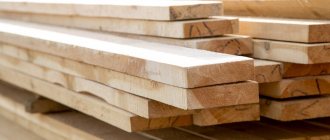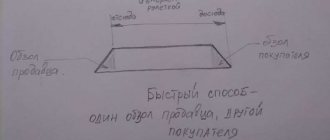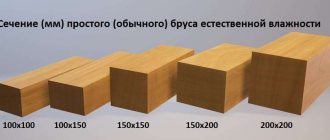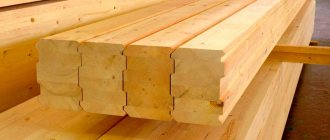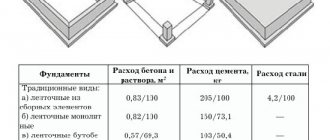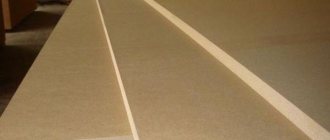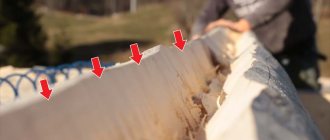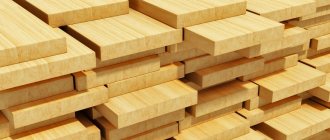How to calculate the cubic capacity of a log house?
This question is the most pressing when it comes to building a house from a log.
How to calculate the cubic capacity of a house yourself? How to check the declared forest cubes in the estimate from the developer? Here is a table showing the cubic capacity of round timber depending on the diameter of the log. These calculations are presented in accordance with GOST 2708-75, which has been in force in the Russian Federation since 1975. The table allows you to calculate how many cubes of round timber will be needed to build a house from logs from the manufacturer.
The standard length of logs used for the construction of log houses is 6 meters. Blanks of this length are most often used. Logs longer than 6 meters are very rarely used for the production of hand-cut houses.
Most often, the architect optimizes the log house according to the cutting map in such a way as to avoid (or minimize) the use of long lengths. It is technically impossible to produce a rounded log over 6 meters.
Below in the table you can see a block of round timber, and for your convenience, we have highlighted a column of 6-meter blanks.
Table for calculating the cubic capacity of round timber with a diameter of 10 to 100 cm and a length of 3 to 8 meters | |||||||||||
| 3m | 3.5 m | 4 m | 4.5 m | 5 m | 5.5 m | 6 m | 6.5 m | 7 m | 7.5 m | 8 m | |
| D 10 cm | 0,026 | 0,031 | 0,037 | 0,044 | 0,051 | 0,058 | 0,065 | 0,075 | 0,082 | 0,09 | 0,1 |
| D 11 cm | 0,032 | 0,037 | 0,045 | 0,053 | 0,062 | 0,07 | 0,08 | 0,09 | 0,098 | 0,108 | 0,12 |
| D 12 cm | 0,038 | 0,046 | 0,053 | 0,063 | 0,073 | 0,083 | 0,093 | 0,103 | 0,114 | 0,125 | 0,138 |
| D 13 cm | 0,045 | 0,053 | 0,062 | 0,075 | 0,085 | 0,097 | 0,108 | 0,12 | 0,132 | 0,144 | 0,158 |
| D 14 cm | 0,052 | 0,061 | 0,073 | 0,084 | 0,097 | 0,11 | 0,123 | 0,135 | 0,15 | 0,164 | 0,179 |
| D 15 cm | 0,06 | 0,071 | 0,084 | 0,097 | 0,11 | 0,125 | 0,139 | 0,153 | 0,169 | 0,182 | 0,199 |
| D 16 cm | 0,069 | 0,082 | 0,095 | 0,11 | 0,124 | 0,14 | 0,155 | 0,172 | 0,189 | 0,2 | 0,22 |
| D 17 cm | 0,077 | 0,092 | 0,107 | 0,124 | 0,14 | 0,157 | 0,174 | 0,191 | 0,209 | 0,225 | 0,25 |
| D 18 cm | 0,086 | 0,103 | 0,12 | 0,138 | 0,156 | 0,175 | 0,194 | 0,21 | 0,23 | 0,25 | 0,28 |
| D 19 cm | 0,097 | 0,115 | 0,134 | 0,154 | 0,173 | 0,193 | 0,212 | 0,235 | 0,255 | 0,275 | 0,305 |
| 3.0 m | 3.5 m | 4.0 m | 4.5 m | 5.0 m | 5.5 m | 6.0 m | 6.5 m | 7.0 m | 7.5 m | 8.0 m | |
| D 20 cm | 0,107 | 0,126 | 0,147 | 0,17 | 0,19 | 0,21 | 0,23 | 0,26 | 0,28 | 0,3 | 0,33 |
| D 21 cm | 0,119 | 0,14 | 0,163 | 0,185 | 0,21 | 0,23 | 0,255 | 0,285 | 0,31 | 0,335 | 0,365 |
| D 22 cm | 0,134 | 0,154 | 0,178 | 0,2 | 0,23 | 0,25 | 0,28 | 0,31 | 0,34 | 0,37 | 0,4 |
| D 23 cm | 0,114 | 0,169 | 0,194 | 0,22 | 0,25 | 0,275 | 0,305 | 0,335 | 0,37 | 0,4 | 0,435 |
| D 24 cm | 0,157 | 0,184 | 0,21 | 0,24 | 0,27 | 0,3 | 0,33 | 0,36 | 0,4 | 0,43 | 0,47 |
| D 25 cm | 0,171 | 0,197 | 0,23 | 0,26 | 0,295 | 0,325 | 0,36 | 0,395 | 0,43 | 0,465 | 0,505 |
| D 26 cm | 0,185 | 0,21 | 0,25 | 0,28 | 0,32 | 0,35 | 0,39 | 0,43 | 0,46 | 0,5 | 0,54 |
| D 27 cm | 0,203 | 0,23 | 0,27 | 0,305 | 0,345 | 0,38 | 0,42 | 0,46 | 0,495 | 0,54 | 0,585 |
| D 28 cm | 0,22 | 0,25 | 0,29 | 0,33 | 0,37 | 0,41 | 0,45 | 0,49 | 0,53 | 0,58 | 0,63 |
| D 29 cm | 0,235 | 0,27 | 0,31 | 0,355 | 0,395 | 0,44 | 0,485 | 0,525 | 0,57 | 0,62 | 0,675 |
| 3m | 3.5 m | 4 m | 4.5 m | 5 m | 5.5 m | 6 m | 6.5 m | 7 m | 7.5 m | 8 m | |
| D 30 cm | 0,25 | 0,29 | 0,33 | 0,38 | 0,42 | 0,47 | 0,52 | 0,56 | 0,61 | 0,66 | 0,72 |
| D 31 mm | 0,265 | 0,31 | 0,355 | 0,405 | 0,45 | 0,5 | 0,555 | 0,6 | 0,655 | 0,72 | 0,77 |
| D 32 cm | 0,28 | 0,33 | 0,38 | 0,43 | 0,48 | 0,53 | 0,59 | 0,64 | 0,7 | 0,76 | 0,82 |
| D 33 cm | 0,3 | 0,35 | 0,405 | 0,46 | 0,51 | 0,565 | 0,625 | 0,68 | 0,74 | 0,805 | 0,87 |
| D 34 cm | 0,32 | 0,37 | 0,43 | 0,49 | 0,54 | 0,6 | 0,66 | 0,72 | 0,78 | 0,85 | 0,92 |
| D 35 cm | 0,34 | 0,395 | 0,455 | 0,515 | 0,57 | 0,635 | 0,7 | 0,76 | 0,83 | 0,9 | 0,97 |
| D 36 cm | 0,36 | 0,42 | 0,48 | 0,54 | 0,6 | 0,67 | 0,74 | 0,8 | 0,88 | 0,95 | 1,02 |
| D 37 cm | 0,375 | 0,44 | 0,505 | 0,57 | 0,635 | 0,705 | 0,78 | 0,85 | 0,925 | 1,0 | 1,075 |
| D 38 cm | 0,39 | 0,46 | 0,53 | 0,6 | 0,67 | 0,74 | 0,82 | 0,9 | 0,97 | 1,05 | 1,13 |
| D 39 cm | 0,41 | 0,48 | 0,555 | 0,63 | 0,705 | 0,78 | 0,86 | 0,945 | 1,02 | 1,105 | 1,19 |
| 3m | 3.5 m | 4 m | 4.5 m | 5 m | 5.5 m | 6 m | 6.5 m | 7 m | 7.5 m | 8 m | |
| D 40 cm | 0,43 | 0,5 | 0,58 | 0,66 | 0,74 | 0,82 | 0,9 | 0,99 | 1,07 | 1,16 | 1,25 |
| D 41 cm | 0,45 | 0,53 | 0,61 | 0,695 | 0,775 | 0,86 | 0,95 | 1,035 | 1,125 | 1,22 | 1,315 |
| D 42 cm | 0,47 | 0,56 | 0,64 | 0,73 | 0,81 | 0,9 | 1,0 | 1,08 | 1,18 | 1,28 | 1,38 |
| D 43 cm | 0,495 | 0,585 | 0,67 | 0,765 | 0,85 | 0,945 | 1,045 | 1,14 | 1,24 | 1,34 | 1,34 |
| D 44 cm | 0,515 | 0,61 | 0,7 | 0,8 | 0,89 | 0,89 | 1,09 | 1,2 | 1,3 | 1,4 | 1,51 |
| D 45 cm | 0,543 | 0,64 | 0,735 | 0,835 | 0,935 | 1,035 | 1,14 | 1,25 | 1,355 | 1,465 | 1,48 |
| D 46 cm | 0,57 | 0,67 | 0,77 | 0,87 | 0,98 | 1,08 | 1,19 | 1,3 | 1,41 | 1,53 | 1,65 |
| D 47 cm | 0,595 | 0,7 | 0,805 | 0,91 | 1,02 | 1,13 | 1,245 | 1,355 | 1,475 | 1,6 | 1,725 |
| D 48 cm | 0,62 | 0,73 | 0,84 | 0,95 | 1,06 | 1,18 | 1,3 | 1,41 | 1,54 | 1,167 | 1,8 |
| D 49 cm | 0,645 | 0,76 | 0,875 | 0,99 | 1,105 | 1,23 | 1,355 | 1,475 | 1,605 | 1,74 | 1,875 |
| 3m | 3.5 m | 4 m | 4.5 m | 5 m | 5.5 m | 6 m | 6.5 m | 7 m | 7.5 m | 8 m | |
| D 50 cm | 0,67 | 0,79 | 0,91 | 1,03 | 1,15 | 1,28 | 1,41 | 1,54 | 1,67 | 1,81 | 1,95 |
| D 51 cm | 0,7 | 0,825 | 0,95 | 1,075 | 1,2 | 1,335 | 1,47 | 1,605 | 1,74 | 1,89 | 2,035 |
| D 52 cm | 0,73 | 0,86 | 0,99 | 1,12 | 1,25 | 1,39 | 1,53 | 1,67 | 1,81 | 1,97 | 2,12 |
| D 53 cm | 0,765 | 0,895 | 1,03 | 1,165 | 1,3 | 1,445 | 1,59 | 1,735 | 1,885 | 2,045 | 2,205 |
| D 54 cm | 0,8 | 0,93 | 1,07 | 1,21 | 1,35 | 1,5 | 1,65 | 1,8 | 1,96 | 2,12 | 2,29 |
| D 55 cm | 0,83 | 0,97 | 1,115 | 1,26 | 1,405 | 1,56 | 1,715 | 1,875 | 2,035 | 2,2 | 2,375 |
| D 56 cm | 0,86 | 1,01 | 1,16 | 1,31 | 1,46 | 1,62 | 1,78 | 1,95 | 2,11 | 2,28 | 2,46 |
| D 57 cm | 0,89 | 1,045 | 1,205 | 1,36 | 1,515 | 1,68 | 1,875 | 2,015 | 2,19 | 2,365 | 2,545 |
| D 58 cm | 0,92 | 1,08 | 1,25 | 1,41 | 1,57 | 1,74 | 1,91 | 2,08 | 2,27 | 2,45 | 2,63 |
| D 59 cm | 0,955 | 1,12 | 1,29 | 1,46 | 1,625 | 1,8 | 1,98 | 2,155 | 2,345 | 2,535 | 2,72 |
| 3m | 3.5 m | 4 m | 4.5 m | 5 m | 5.5 m | 6 m | 6.5 m | 7 m | 7.5 m | 8 m | |
| D 60 cm | 0,99 | 1,16 | 1,33 | 1,151 | 1,151 | 1,86 | 2,05 | 2,23 | 2,42 | 2,62 | 2,81 |
| D 61 cm | 1,025 | 1,2 | 1,38 | 1,565 | 1,74 | 1,925 | 2,115 | 2,3 | 2,495 | 2,7 | 2,9 |
| D 62 cm | 1,06 | 1,24 | 1,43 | 1,62 | 1,8 | 1,99 | 2,18 | 2,37 | 2,57 | 2,78 | 2,99 |
| D 63 cm | 1,095 | 1,285 | 1,475 | 1,67 | 1,855 | 2,05 | 2,25 | 2,445 | 2,65 | 2,865 | 3,08 |
| D 64 cm | 1,13 | 1,33 | 1,52 | 1,72 | 1,61 | 2,11 | 2,32 | 2,52 | 2,73 | 2,95 | 3,17 |
| D 65 cm | 1,165 | 1,365 | 1,565 | 1,77 | 1,965 | 2,17 | 2,38 | 2,59 | 2,805 | 3,03 | 3,275 |
| D 66 cm | 1,2 | 1,4 | 1,61 | 1,82 | 2,02 | 2,23 | 2,44 | 2,66 | 2,88 | 3,11 | 3,38 |
| D 67 cm | 1,235 | 1,445 | 1,655 | 1,87 | 2,075 | 2,29 | 2,505 | 2,735 | 2,965 | 3,21 | 3,485 |
| D 68 cm | 1,27 | 1,49 | 1,7 | 1,92 | 2,13 | 2,35 | 2,57 | 2,81 | 3,05 | 3,31 | 3,59 |
| D 69 cm | 1,305 | 1,53 | 1,75 | 1,97 | 2,19 | 2,415 | 2,645 | 2,89 | 3,14 | 3,41 | 3,695 |
| 3m | 3.5 m | 4 m | 4.5 m | 5 m | 5.5 m | 6 m | 6.5 m | 7 m | 7.5 m | 8 m | |
| D 70 cm | 1,34 | 1,57 | 1,8 | 2,02 | 2,25 | 2,48 | 2,72 | 2,97 | 3,23 | 3,51 | 3,8 |
| D 71 cm | 1,375 | 1,615 | 1,85 | 2,08 | 2,315 | 2,55 | 2,795 | 3,055 | 3,325 | 3,615 | 3,91 |
| D 72 cm | 1,41 | 1,66 | 1,9 | 2,14 | 2,38 | 2,62 | 2,87 | 3,14 | 3,42 | 3,72 | 4,02 |
| D 73 cm | 1,45 | 1,705 | 1,955 | 2,2 | 2,45 | 2,695 | 2,95 | 3,23 | 3,52 | 3,82 | 4,135 |
| D 74 cm | 1,49 | 1,75 | 2,01 | 2,26 | 2,52 | 2,77 | 3,03 | 3,32 | 3,62 | 3,92 | 4,25 |
| D 75 cm | 1,53 | 1,8 | 2,065 | 2,325 | 2,595 | 2,845 | 3,115 | 3,415 | 3,715 | 4,03 | 4,365 |
| D 76 cm | 1,57 | 1,85 | 2,12 | 2,39 | 2,67 | 2,92 | 3,2 | 3,51 | 3,81 | 4,14 | 4,48 |
| D 77 cm | 1,615 | 1,9 | 2,18 | 2,455 | 2,745 | 3,0 | 3,29 | 3,605 | 3,925 | 4,255 | 4,6 |
| D 78 cm | 1,66 | 1,95 | 2,24 | 2,52 | 2,82 | 3,08 | 3,38 | 3,7 | 4,04 | 4,37 | 4,72 |
| D 79 cm | 1,7 | 2,0 | 2,295 | 2,59 | 2,895 | 3,16 | 3,475 | 3,8 | 4,15 | 4,485 | 4,835 |
| 3m | 3.5 m | 4 m | 4.5 m | 5 m | 5.5 m | 6 m | 6.5 m | 7 m | 7.5 m | 8 m | |
| D 80 cm | 1,74 | 2,05 | 2,35 | 2,66 | 2,97 | 3,24 | 3,57 | 3,9 | 4,26 | 4,6 | 4,95 |
| D 81 cm | 1,785 | 2,1 | 2,41 | 2,73 | 3,05 | 3,325 | 3,66 | 4,005 | 4,365 | 4,51 | 5,085 |
| D 82 cm | 1,83 | 2,15 | 2,47 | 2,8 | 3,13 | 3,41 | 3,75 | 4,11 | 4,47 | 4,82 | 5,22 |
| D 83 cm | 1,875 | 2,205 | 2,53 | 2,87 | 3,205 | 3,495 | 3,845 | 4,215 | 4,585 | 4,495 | 5,345 |
| D 84 cm | 1,92 | 2,26 | 2,59 | 2,94 | 3,28 | 3,58 | 3,94 | 4,32 | 4,7 | 5,07 | 5,47 |
| D 85 cm | 1,965 | 2,315 | 2,65 | 2,985 | 3,34 | 3,675 | 4,035 | 4,43 | 4,82 | 5,195 | 5,595 |
| D 86 cm | 2,01 | 2,37 | 2,71 | 3,03 | 3,4 | 3,77 | 4,13 | 4,54 | 4,94 | 5,32 | 5,72 |
| D 87 cm | 2,06 | 2,425 | 2,78 | 3,13 | 3,5 | 3,86 | 4,235 | 4,655 | 5,06 | 5,445 | 5,86 |
| D 88 cm | 2,11 | 2,48 | 2,85 | 3,23 | 3,6 | 3,95 | 4,34 | 4,77 | 5,18 | 5,57 | 6,0 |
| D 89 cm | 2,16 | 2,535 | 2,915 | 3,3 | 3,685 | 4,045 | 4,45 | 4,88 | 5,3 | 5,7 | 6,135 |
| 3m | 3.5 m | 4 m | 4.5 m | 5 m | 5.5 m | 6 m | 6.5 m | 7 m | 7.5 m | 8 m | |
| D 90 cm | 2,21 | 2,59 | 2,98 | 3,37 | 3,77 | 4,145 | 4,56 | 4,99 | 5,42 | 5,83 | 6,27 |
| D 91 cm | 2,255 | 2,65 | 3,045 | 3,45 | 3,45 | 4,24 | 4,67 | 5,105 | 5,545 | 5,96 | 6,41 |
| D 92 cm | 2,3 | 2,71 | 3,11 | 3,53 | 3,94 | 4,34 | 4,78 | 5,22 | 5,67 | 6,09 | 6,55 |
| D 93 cm | 2,355 | 2,77 | 3,18 | 3,605 | 4,025 | 4,43 | 4,89 | 5,345 | 5,795 | 6,225 | 6,69 |
| D 94 cm | 2,41 | 2,83 | 3,25 | 3,68 | 4,11 | 4,52 | 5,0 | 5,47 | 5,92 | 6,36 | 6,83 |
| D 95 cm | 2,46 | 2,89 | 3,32 | 3,76 | 4,2 | 4,625 | 5,11 | 5,58 | 6,045 | 6,495 | 6,975 |
| D 96 cm | 2,51 | 2,95 | 3,39 | 3,84 | 4,29 | 4,73 | 5,22 | 5,69 | 6,17 | 6,63 | 7,12 |
| D 97 cm | 2,565 | 3,01 | 3,46 | 3,92 | 4,38 | 4,83 | 5,335 | 5,81 | 6,3 | 6,77 | 7,28 |
| D 98 cm | 2,62 | 3,07 | 3,53 | 4,0 | 4,47 | 4,93 | 5,45 | 5,93 | 6,43 | 6,91 | 7,44 |
| D 99 cm | 2,67 | 3,135 | 3,6 | 4,085 | 4,56 | 5,035 | 5,565 | 6,06 | 6,565 | 7,055 | 7,585 |
| D 100 cm | 2,72 | 3,2 | 3,67 | 4,17 | 4,65 | 5,14 | 5,68 | 6,19 | 6,7 | 7,2 | 7,73 |
How many edged and planed boards are in 1 cube | TABLE
The number of boards in one cube depends on the size of the canvas. A board measuring 20x20x600 will have a quantity of 417 pieces per 1m3. To simplify the calculation, we have prepared a summary table for you. The table allows you to immediately find out how many boards are in 1m3 of a certain thickness, width, length without spending time on calculations. To make you feel comfortable.
4 meter boards | TABLE
| Thickness, mm | Width, mm | Length, mm | volume, m3 | Amount |
| 20 | 20 | 4000 | 0.0016 | 625 |
| 20 | 50 | 4000 | 0.0040 | 250 |
| 20 | 60 | 4000 | 0.0048 | 208 |
| 20 | 70 | 4000 | 0.0056 | 179 |
| 20 | 80 | 4000 | 0.0064 | 156 |
| 20 | 90 | 4000 | 0.0072 | 139 |
| 20 | 100 | 4000 | 0.0080 | 125 |
| 20 | 120 | 4000 | 0.0096 | 104 |
| 20 | 150 | 4000 | 0.0120 | 83 |
| 20 | 180 | 4000 | 0.0144 | 69 |
| 20 | 200 | 4000 | 0.0160 | 63 |
| 20 | 250 | 4000 | 0.0200 | 50 |
| 20 | 300 | 4000 | 0.0240 | 42 |
| 25 | 20 | 4000 | 0.0020 | 500 |
| 25 | 25 | 4000 | 0.0025 | 400 |
| 25 | 40 | 4000 | 0.0040 | 250 |
| 25 | 50 | 4000 | 0.0050 | 200 |
| 25 | 60 | 4000 | 0.0060 | 167 |
| 25 | 70 | 4000 | 0.0070 | 143 |
| 25 | 80 | 4000 | 0.0080 | 125 |
| 25 | 90 | 4000 | 0.0090 | 111 |
| 25 | 100 | 4000 | 0.0100 | 100 |
| 25 | 120 | 4000 | 0.0120 | 83 |
| 25 | 150 | 4000 | 0.0150 | 67 |
| 25 | 180 | 4000 | 0.0180 | 56 |
| 25 | 200 | 4000 | 0.0200 | 50 |
| 25 | 250 | 4000 | 0.0250 | 40 |
| 25 | 300 | 4000 | 0.0300 | 33 |
| 30 | 20 | 4000 | 0.0024 | 417 |
| 30 | 25 | 4000 | 0.0030 | 333 |
| 30 | 30 | 4000 | 0.0036 | 278 |
| 30 | 40 | 4000 | 0.0048 | 208 |
| 30 | 50 | 4000 | 0.0060 | 167 |
| 30 | 60 | 4000 | 0.0072 | 139 |
| 30 | 70 | 4000 | 0.0084 | 119 |
| 30 | 80 | 4000 | 0.0096 | 104 |
| 30 | 90 | 4000 | 0.0108 | 93 |
| 30 | 100 | 4000 | 0.0120 | 83 |
| 30 | 120 | 4000 | 0.0144 | 69 |
| 30 | 150 | 4000 | 0.0180 | 56 |
| 30 | 180 | 4000 | 0.0216 | 46 |
| 30 | 200 | 4000 | 0.0240 | 42 |
| 30 | 250 | 4000 | 0.0300 | 33 |
| 30 | 300 | 4000 | 0.0360 | 28 |
| 40 | 20 | 4000 | 0.0032 | 313 |
| 40 | 40 | 4000 | 0.0064 | 156 |
| 40 | 50 | 4000 | 0.0080 | 125 |
| 40 | 60 | 4000 | 0.0096 | 104 |
| 40 | 70 | 4000 | 0.0112 | 89 |
| 40 | 80 | 4000 | 0.0128 | 78 |
| 40 | 90 | 4000 | 0.0144 | 69 |
| 40 | 100 | 4000 | 0.0160 | 63 |
| 40 | 120 | 4000 | 0.0192 | 52 |
| 40 | 150 | 4000 | 0.0240 | 42 |
| 40 | 180 | 4000 | 0.0288 | 35 |
| 40 | 200 | 4000 | 0.0320 | 31 |
| 40 | 250 | 4000 | 0.0400 | 25 |
| 40 | 300 | 4000 | 0.0480 | 21 |
| 50 | 50 | 4000 | 0.0100 | 100 |
| 50 | 60 | 4000 | 0.0120 | 83 |
| 50 | 70 | 4000 | 0.0140 | 71 |
| 50 | 80 | 4000 | 0.0160 | 63 |
| 50 | 90 | 4000 | 0.0180 | 56 |
| 50 | 100 | 4000 | 0.0200 | 50 |
| 50 | 120 | 4000 | 0.0240 | 42 |
| 50 | 150 | 4000 | 0.0300 | 33 |
| 50 | 180 | 4000 | 0.0360 | 28 |
| 50 | 200 | 4000 | 0.0400 | 25 |
| 50 | 250 | 4000 | 0.0500 | 20 |
| 50 | 300 | 4000 | 0.0600 | 17 |
| 60 | 60 | 4000 | 0.0144 | 69 |
| 60 | 70 | 4000 | 0.0168 | 60 |
| 60 | 80 | 4000 | 0.0192 | 52 |
| 60 | 90 | 4000 | 0.0216 | 46 |
| 60 | 100 | 4000 | 0.0240 | 42 |
| 60 | 120 | 4000 | 0.0288 | 35 |
| 60 | 150 | 4000 | 0.0360 | 28 |
| 60 | 180 | 4000 | 0.0432 | 23 |
| 60 | 200 | 4000 | 0.0480 | 21 |
| 60 | 250 | 4000 | 0.0600 | 17 |
| 60 | 300 | 4000 | 0.0720 | 14 |
| 70 | 70 | 4000 | 0.0196 | 51 |
| 70 | 80 | 4000 | 0.0224 | 45 |
| 70 | 90 | 4000 | 0.0252 | 40 |
| 70 | 100 | 4000 | 0.0280 | 36 |
| 70 | 120 | 4000 | 0.0336 | 30 |
| 70 | 150 | 4000 | 0.0420 | 24 |
| 70 | 180 | 4000 | 0.0504 | 20 |
| 70 | 200 | 4000 | 0.0560 | 18 |
| 70 | 250 | 4000 | 0.0700 | 14 |
| 70 | 300 | 4000 | 0.0840 | 12 |
| 80 | 80 | 4000 | 0.0256 | 39 |
| 80 | 90 | 4000 | 0.0288 | 35 |
| 80 | 100 | 4000 | 0.0320 | 31 |
| 80 | 120 | 4000 | 0.0384 | 26 |
| 80 | 150 | 4000 | 0.0480 | 21 |
| 80 | 180 | 4000 | 0.0576 | 17 |
| 80 | 200 | 4000 | 0.0640 | 16 |
| 80 | 250 | 4000 | 0.0800 | 13 |
| 80 | 300 | 4000 | 0.0960 | 10 |
| 90 | 90 | 4000 | 0.0324 | 31 |
| 90 | 100 | 4000 | 0.0360 | 28 |
| 90 | 120 | 4000 | 0.0432 | 23 |
| 90 | 150 | 4000 | 0.0540 | 19 |
| 90 | 180 | 4000 | 0.0648 | 15 |
| 90 | 200 | 4000 | 0.0720 | 14 |
| 90 | 250 | 4000 | 0.0900 | 11 |
| 90 | 300 | 4000 | 0.1080 | 9 |
5 meter boards | TABLE
| Thickness, mm | Width, mm | Length, mm | volume, m3 | Amount |
| 20 | 20 | 5000 | 0.0020 | 500 |
| 20 | 50 | 5000 | 0.0050 | 200 |
| 20 | 60 | 5000 | 0.0060 | 167 |
| 20 | 70 | 5000 | 0.0070 | 143 |
| 20 | 80 | 5000 | 0.0080 | 125 |
| 20 | 90 | 5000 | 0.0090 | 111 |
| 20 | 100 | 5000 | 0.0100 | 100 |
| 20 | 120 | 5000 | 0.0120 | 83 |
| 20 | 150 | 5000 | 0.0150 | 67 |
| 20 | 180 | 5000 | 0.0180 | 56 |
| 20 | 200 | 5000 | 0.0200 | 50 |
| 20 | 250 | 5000 | 0.0250 | 40 |
| 20 | 300 | 5000 | 0.0300 | 33 |
| 25 | 20 | 5000 | 0.0025 | 400 |
| 25 | 25 | 5000 | 0.0031 | 320 |
| 25 | 40 | 5000 | 0.0050 | 200 |
| 25 | 50 | 5000 | 0.0063 | 160 |
| 25 | 60 | 5000 | 0.0075 | 133 |
| 25 | 70 | 5000 | 0.0088 | 114 |
| 25 | 80 | 5000 | 0.0100 | 100 |
| 25 | 90 | 5000 | 0.0113 | 89 |
| 25 | 100 | 5000 | 0.0125 | 80 |
| 25 | 120 | 5000 | 0.0150 | 67 |
| 25 | 150 | 5000 | 0.0188 | 53 |
| 25 | 180 | 5000 | 0.0225 | 44 |
| 25 | 200 | 5000 | 0.0250 | 40 |
| 25 | 250 | 5000 | 0.0313 | 32 |
| 25 | 300 | 5000 | 0.0375 | 27 |
| 30 | 20 | 5000 | 0.0030 | 333 |
| 30 | 25 | 5000 | 0.0038 | 267 |
| 30 | 30 | 5000 | 0.0045 | 222 |
| 30 | 40 | 5000 | 0.0060 | 167 |
| 30 | 50 | 5000 | 0.0075 | 133 |
| 30 | 60 | 5000 | 0.0090 | 111 |
| 30 | 70 | 5000 | 0.0105 | 95 |
| 30 | 80 | 5000 | 0.0120 | 83 |
| 30 | 90 | 5000 | 0.0135 | 74 |
| 30 | 100 | 5000 | 0.0150 | 67 |
| 30 | 120 | 5000 | 0.0180 | 56 |
| 30 | 150 | 5000 | 0.0225 | 44 |
| 30 | 180 | 5000 | 0.0270 | 37 |
| 30 | 200 | 5000 | 0.0300 | 33 |
| 30 | 250 | 5000 | 0.0375 | 27 |
| 30 | 300 | 5000 | 0.0450 | 22 |
| 40 | 20 | 5000 | 0.0040 | 250 |
| 40 | 40 | 5000 | 0.0080 | 125 |
| 40 | 50 | 5000 | 0.0100 | 100 |
| 40 | 60 | 5000 | 0.0120 | 83 |
| 40 | 70 | 5000 | 0.0140 | 71 |
| 40 | 80 | 5000 | 0.0160 | 63 |
| 40 | 90 | 5000 | 0.0180 | 56 |
| 40 | 100 | 5000 | 0.0200 | 50 |
| 40 | 120 | 5000 | 0.0240 | 42 |
| 40 | 150 | 5000 | 0.0300 | 33 |
| 40 | 180 | 5000 | 0.0360 | 28 |
| 40 | 200 | 5000 | 0.0400 | 25 |
| 40 | 250 | 5000 | 0.0500 | 20 |
| 40 | 300 | 5000 | 0.0600 | 17 |
| 50 | 50 | 5000 | 0.0125 | 80 |
| 50 | 60 | 5000 | 0.0150 | 67 |
| 50 | 70 | 5000 | 0.0175 | 57 |
| 50 | 80 | 5000 | 0.0200 | 50 |
| 50 | 90 | 5000 | 0.0225 | 44 |
| 50 | 100 | 5000 | 0.0250 | 40 |
| 50 | 120 | 5000 | 0.0300 | 33 |
| 50 | 150 | 5000 | 0.0375 | 27 |
| 50 | 180 | 5000 | 0.0450 | 22 |
| 50 | 200 | 5000 | 0.0500 | 20 |
| 50 | 250 | 5000 | 0.0625 | 16 |
| 50 | 300 | 5000 | 0.0750 | 13 |
| 60 | 60 | 5000 | 0.0180 | 56 |
| 60 | 70 | 5000 | 0.0210 | 48 |
| 60 | 80 | 5000 | 0.0240 | 42 |
| 60 | 90 | 5000 | 0.0270 | 37 |
| 60 | 100 | 5000 | 0.0300 | 33 |
| 60 | 120 | 5000 | 0.0360 | 28 |
| 60 | 150 | 5000 | 0.0450 | 22 |
| 60 | 180 | 5000 | 0.0540 | 19 |
| 60 | 200 | 5000 | 0.0600 | 17 |
| 60 | 250 | 5000 | 0.0750 | 13 |
| 60 | 300 | 5000 | 0.0900 | 11 |
| 70 | 70 | 5000 | 0.0245 | 41 |
| 70 | 80 | 5000 | 0.0280 | 36 |
| 70 | 90 | 5000 | 0.0315 | 32 |
| 70 | 100 | 5000 | 0.0350 | 29 |
| 70 | 120 | 5000 | 0.0420 | 24 |
| 70 | 150 | 5000 | 0.0525 | 19 |
| 70 | 180 | 5000 | 0.0630 | 16 |
| 70 | 200 | 5000 | 0.0700 | 14 |
| 70 | 250 | 5000 | 0.0875 | 11 |
| 70 | 300 | 5000 | 0.1050 | 10 |
| 80 | 80 | 5000 | 0.0320 | 31 |
| 80 | 90 | 5000 | 0.0360 | 28 |
| 80 | 100 | 5000 | 0.0400 | 25 |
| 80 | 120 | 5000 | 0.0480 | 21 |
| 80 | 150 | 5000 | 0.0600 | 17 |
| 80 | 180 | 5000 | 0.0720 | 14 |
| 80 | 200 | 5000 | 0.0800 | 13 |
| 80 | 250 | 5000 | 0.1000 | 10 |
| 80 | 300 | 5000 | 0.1200 | 8 |
| 90 | 90 | 5000 | 0.0405 | 25 |
| 90 | 100 | 5000 | 0.0450 | 22 |
| 90 | 120 | 5000 | 0.0540 | 19 |
| 90 | 150 | 5000 | 0.0675 | 15 |
| 90 | 180 | 5000 | 0.0810 | 12 |
| 90 | 200 | 5000 | 0.0900 | 11 |
| 90 | 250 | 5000 | 0.1125 | 9 |
| 90 | 300 | 5000 | 0.1350 | 7 |
6 meter boards | TABLE
| Thickness, mm | Width, mm | Length, mm | volume, m3 | Amount |
| 20 | 20 | 6000 | 0.0024 | 417 |
| 20 | 50 | 6000 | 0.0060 | 167 |
| 20 | 60 | 6000 | 0.0072 | 139 |
| 20 | 70 | 6000 | 0.0084 | 119 |
| 20 | 80 | 6000 | 0.0096 | 104 |
| 20 | 90 | 6000 | 0.0108 | 93 |
| 20 | 100 | 6000 | 0.0120 | 83 |
| 20 | 120 | 6000 | 0.0144 | 69 |
| 20 | 150 | 6000 | 0.0180 | 56 |
| 20 | 180 | 6000 | 0.0216 | 46 |
| 20 | 200 | 6000 | 0.0240 | 42 |
| 20 | 250 | 6000 | 0.0300 | 33 |
| 20 | 300 | 6000 | 0.0360 | 28 |
| 25 | 20 | 6000 | 0.0030 | 333 |
| 25 | 25 | 6000 | 0.0038 | 267 |
| 25 | 40 | 6000 | 0.0060 | 167 |
| 25 | 50 | 6000 | 0.0075 | 133 |
| 25 | 60 | 6000 | 0.0090 | 111 |
| 25 | 70 | 6000 | 0.0105 | 95 |
| 25 | 80 | 6000 | 0.0120 | 83 |
| 25 | 90 | 6000 | 0.0135 | 74 |
| 25 | 100 | 6000 | 0.0150 | 67 |
| 25 | 120 | 6000 | 0.0180 | 56 |
| 150 | 6000 | 0.0225 | 44 | |
| 25 | 180 | 6000 | 0.0270 | 37 |
| 25 | 200 | 6000 | 0.0300 | 33 |
| 25 | 250 | 6000 | 0.0375 | 27 |
| 25 | 300 | 6000 | 0.0450 | 22 |
| 30 | 20 | 6000 | 0.0036 | 278 |
| 30 | 25 | 6000 | 0.0045 | 222 |
| 30 | 30 | 6000 | 0.0054 | 185 |
| 30 | 40 | 6000 | 0.0072 | 139 |
| 30 | 50 | 6000 | 0.0090 | 111 |
| 30 | 60 | 6000 | 0.0108 | 93 |
| 30 | 70 | 6000 | 0.0126 | 79 |
| 30 | 80 | 6000 | 0.0144 | 69 |
| 30 | 90 | 6000 | 0.0162 | 62 |
| 30 | 100 | 6000 | 0.0180 | 56 |
| 30 | 120 | 6000 | 0.0216 | 46 |
| 30 | 150 | 6000 | 0.0270 | 37 |
| 30 | 180 | 6000 | 0.0324 | 31 |
| 30 | 200 | 6000 | 0.0360 | 28 |
| 30 | 250 | 6000 | 0.0450 | 22 |
| 30 | 300 | 6000 | 0.0540 | 19 |
| 40 | 20 | 6000 | 0.0048 | 208 |
| 40 | 40 | 6000 | 0.0096 | 104 |
| 40 | 50 | 6000 | 0.0120 | 83 |
| 40 | 60 | 6000 | 0.0144 | 69 |
| 40 | 70 | 6000 | 0.0168 | 60 |
| 40 | 80 | 6000 | 0.0192 | 52 |
| 40 | 90 | 6000 | 0.0216 | 46 |
| 40 | 100 | 6000 | 0.0240 | 42 |
| 40 | 120 | 6000 | 0.0288 | 35 |
| 150 | 6000 | 0.0360 | 28 | |
| 40 | 180 | 6000 | 0.0432 | 23 |
| 40 | 200 | 6000 | 0.0480 | 21 |
| 40 | 250 | 6000 | 0.0600 | 17 |
| 40 | 300 | 6000 | 0.0720 | 14 |
| 50 | 50 | 6000 | 0.0150 | 67 |
| 50 | 60 | 6000 | 0.0180 | 56 |
| 50 | 70 | 6000 | 0.0210 | 48 |
| 50 | 80 | 6000 | 0.0240 | 42 |
| 50 | 90 | 6000 | 0.0270 | 37 |
| 50 | 100 | 6000 | 0.0300 | 33 |
| 50 | 120 | 6000 | 0.0360 | 28 |
| 150 | 6000 | 0.0450 | 22 | |
| 50 | 180 | 6000 | 0.0540 | 19 |
| 50 | 200 | 6000 | 0.0600 | 17 |
| 50 | 250 | 6000 | 0.0750 | 13 |
| 50 | 300 | 6000 | 0.0900 | 11 |
| 60 | 60 | 6000 | 0.0216 | 46 |
| 60 | 70 | 6000 | 0.0252 | 40 |
| 60 | 80 | 6000 | 0.0288 | 35 |
| 60 | 90 | 6000 | 0.0324 | 31 |
| 60 | 100 | 6000 | 0.0360 | 28 |
| 60 | 120 | 6000 | 0.0432 | 23 |
| 60 | 150 | 6000 | 0.0540 | 19 |
| 60 | 180 | 6000 | 0.0648 | 15 |
| 60 | 200 | 6000 | 0.0720 | 14 |
| 60 | 250 | 6000 | 0.0900 | 11 |
| 60 | 300 | 6000 | 0.1080 | 9 |
| 70 | 70 | 6000 | 0.0294 | 34 |
| 70 | 80 | 6000 | 0.0336 | 30 |
| 70 | 90 | 6000 | 0.0378 | 26 |
| 70 | 100 | 6000 | 0.0420 | 24 |
| 70 | 120 | 6000 | 0.0504 | 20 |
| 70 | 150 | 6000 | 0.0630 | 16 |
| 70 | 180 | 6000 | 0.0756 | 13 |
| 70 | 200 | 6000 | 0.0840 | 12 |
| 70 | 250 | 6000 | 0.1050 | 10 |
| 70 | 300 | 6000 | 0.1260 | 8 |
| 80 | 80 | 6000 | 0.0384 | 26 |
| 80 | 90 | 6000 | 0.0432 | 23 |
| 80 | 100 | 6000 | 0.0480 | 21 |
| 80 | 120 | 6000 | 0.0576 | 17 |
| 80 | 150 | 6000 | 0.0720 | 14 |
| 80 | 180 | 6000 | 0.0864 | 12 |
| 80 | 200 | 6000 | 0.0960 | 10 |
| 80 | 250 | 6000 | 0.1200 | 8 |
| 80 | 300 | 6000 | 0.1440 | 7 |
| 90 | 90 | 6000 | 0.0486 | 21 |
| 90 | 100 | 6000 | 0.0540 | 19 |
| 90 | 120 | 6000 | 0.0648 | 15 |
| 90 | 150 | 6000 | 0.0810 | 12 |
| 90 | 180 | 6000 | 0.0972 | 10 |
| 90 | 200 | 6000 | 0.1080 | 9 |
| 90 | 250 | 6000 | 0.1350 | 7 |
| 90 | 300 | 6000 | 0.1620 | 6 |
Now all you need is to save a table of sizes and volumes of edged and planed boards, and refer to it if necessary.
How is the cubic capacity of a wooden house calculated during preliminary calculations?
First you need to calculate how many blanks are needed to build a house from a log. In finished projects from "AZBUKA LESA" this information is contained in the "Cutting Cards" section. The photo below shows summary information for the construction of a house made from rounded logs “Severyanin” according to the project.
This data is for a rounded log with a diameter of 240 mm and a length of 6 meters. We see from the cutting map that for construction we will need 547 blanks; when converted to cubic meters according to the table presented above, it turns out to be 146.71 m3. These data are automatically calculated by the AT - WENTS program.
The program in which our architects design wooden houses gives the exact cubic capacity without window and door openings, taking into account all the design features of a wooden house. It is almost impossible to achieve such accuracy with manual calculations.
To manually calculate the cubic capacity for such a number of workpieces, we use a table.
We see in the corresponding cell that the volume of one log is 0.33 m3.
547*0.33= 180.51 m3.
Thus, we got the result taking into account the lunar groove - the log, relatively speaking, is calculated as a cylinder, and the program calculates minus the lunar groove.
This calculation once again proves the importance of a professional project and the availability of cutting maps, which allow you to very accurately calculate the amount of logs and lumber and rationally use the construction budget. But for approximate calculations to understand the order of prices, this method is very informative.
Mathematical method for calculating the cubic capacity of a wooden house (with a practical example)
What to do if you liked the house in the picture, and you don’t have a complete project, much less a cutting map? In this case, you need to be patient and manually calculate the length of all the logs according to the plan. It must be understood that in this case the error with the real result can be significant, and in both directions.
The task is to calculate how many blanks are needed to build a house from a log. The standard length of a log, as we have previously informed you, often does not exceed 6 meters. It is very important at this stage to determine the height of the floors! And according to this, calculate the number of crowns.
To do this, we need a table of the height of the log profile depending on the diameter.
It is presented below. We count the length of all crowns (logs), including pediments, and divide the resulting number by 6. Height of the profile of a round log
| Log diameter, mm | Crown height, m | Crown height, mm |
| 220 | 0,1905 | 190,5 |
| 240 | 0,2078 | 207,8 |
| 260 | 0,2252 | 225,2 |
| 280 | 0,2425 | 242,5 |
| 300 | 0,2598 | 259,8 |
| 320 | 0,2771 | 277,1 |
| 340 | 0,2944 | 294,4 |
| 360 | 0,3225 | 322,5 |
| 380 | 0,3399 | 339,9 |
| 400 | 0,3572 | 357,2 |
EXAMPLE:
Let's assume that we want to build a house from chopped logs with a diameter of 320 mm. One full floor, the second floor is an attic. The desired height of the first floor after shrinkage is 3100 mm, the desired height of the attic near the wall is 1500 mm. The height of one crown with a diameter of 320 mm is 0.2771 mm.
Important! The average height of the first floor of any log house before shrinkage is 3.2 m, the height of the attic wall in the attic is on average 1.5-1.7 m. After shrinkage, the height of the walls will decrease by approximately 7-10%, so this must be taken into account in the initial calculations . It is also necessary to take into account the composition of the floor of the first and second floors. A competent architect will always tell you how to do this correctly.
So, in our example:
- First floor before shrinkage: 12 crowns, which will be equal to 3.33 m.
- Attic wall in the attic before shrinkage: 6 crowns, which is equal to 1.66 m.
Now we need the length of the walls of each floor.
To do this, it is necessary to calculate the perimeter of all walls (load-bearing and internal) according to the plan. Let's assume that the length of the first floor is 100 linear meters, and the length of the attic floor is 85 m.p.
This is the result without subtracting window and door openings. If you need a more accurate number, then you need to calculate all openings in length and height and subtract them from the total number.
We will consider a more simplified version of calculating the cubic capacity of a log house from the manufacturer.
Working with ready-made cubic capacity calculations
Of course, not all standard sizes are given here, but as an example it can be seen that the cubic capacity of various logs was calculated with great accuracy. In practice, the thickness (diameter) is measured, as indicated in GOST, then the length and the cubic capacity are found from the table. Since the cut circle of the log is not ideal in shape, 2 diameter measurements are taken perpendicularly and its average value is found. It is this value that you need to look for in the line.
Figure 2. Using a measuring fork, you can measure the diameter and calculate the cubic capacity of a tree.
Example. A 6-meter log in the upper cut has 2 diameter sizes (30 and 34 cm excluding bark), measured perpendicularly. We find the average value of the cut diameter is 32 cm. The length of the log is 6 m. From the table we find that at the intersection of the row with the value of 32 cm and the column of 6 m there is a volume value of 0.59 m³. If the log is rounded, then just one diameter measurement is enough. The error of the results is 2-4%, which is acceptable for most practical calculations.
When harvesting timber for a home, each log can be measured, but there is not always enough time and effort for this. Here they use an industrial method for calculating cubic capacity. The timber is sorted by length and then by equal top diameters. Measurements are made in each group of one product.
And only after stacking in stacks or in a machine, the quantity is counted and the total cubic capacity is calculated by simply multiplying the number of logs by the volume of one of them.
In the forestry industry, for taxation (determining the stock of standing timber), in addition to simple tools, there are special electronic devices for measuring and calculating the parameters of standing trees.
Masser 2000 is a computerized measuring fork that allows you not only to accurately measure the reference diameter of a standing tree at a height of 1.3 m, but also to immediately determine the cubic capacity taking into account the type, height and crown of the tree. The device then outputs all collected information to the computer (Fig. 2).
The cubic capacity of a log is the volume of wood material, measured in cubic meters. This value is used in the construction of wooden log houses to calculate the amount of round timber. Determining cubic capacity is important when selling firewood, where payment is provided for each cubic meter of wood. How to calculate the volume of round cylindrical lumber correctly?
It is necessary to know the cubic capacity of a tree when purchasing this building material, since payment is made for each cubic meter.
There are several ways to roughly estimate the cubic capacity of roundwood or firewood. All established methods use data from measuring geometric dimensions and mathematical calculations.
A tape measure is traditionally used to measure construction values.
Volume calculation using tables
Calculating the volume of round timber using tables involves measuring the diameter and obtaining data from ready-made construction tables.
Such directories contain structured information indicating the consumption of lumber of a given diameter for the construction of 1 m² of wall. Such tables are the result of construction calculations and established practice in determining lumber consumption. Therefore, they make it possible to fairly accurately estimate the cubic capacity of scaffolding. A set of tables compiled into a single standardized document is called GOST.
Most often, the tables are calculated for a rounded log, from which the top layer and bark have been removed, the surface has been leveled to a regular cylinder.
If desired, you can use the table data to determine the amount of unedged wood, making allowances for possible inaccuracies. Errors in the results obtained will be associated with changes in the cross-sectional diameter of the round timber along its length.
Independent calculation of the quantity of round timber allows you to verify that the seller has determined the price correctly. It is economically feasible to check a team of contractors by conducting your own approximate calculations of the consumption of construction logs for the construction of the walls of the house.
For many builders, the topic of calculating the number of logs in a cube is familiar. But for an unprepared person this may seem not only very distant, but also incomprehensible. And very often disagreements arise between the builders themselves, as well as between the builders and the customer, about how many logs there should be in a cube.
In order to deal with this problem, a mathematical method is usually used, which in a few minutes can give a clear answer about how many logs are needed for a certain number of cubic meters.
As a rule, rounded logs are used in the construction of wooden buildings. But this material may differ in size, that is, in length and diameter. The unit of measurement is usually centimeters. There are one million centimeters in one cubic meter. Thus, first you need to decide on the size of the logs.
In order to measure the size of the logs, you will need a regular centimeter tape measure. All logs, as a rule, should initially be the same size, and later, depending on the project, they are sawn into the necessary elements.
So, by measuring the size of a log using a tape measure, we obtain the length and diameter in centimeters. For example, let's try to calculate how many logs are needed for one cubic meter, if the logs are six meters long and their diameter is eighteen centimeters.
Calculation of the volume of individual logs
Figure 1. Measuring two perpendicular diameters in a beam cross-section
If the round timber is characterized by the same long logs and similar diameter, then you can calculate the volume of selectively 3 timbers, reduce them to the average calculated value and multiply it by the amount of log material. In this case, the calculations are performed as follows:
- Choose any 3 timbers.
- Measure their diameter and length. For ease of calculation, measurements are made in meters.
- Calculate the cubic space occupied by each of the round timbers using the formula:
where Pi is a number equal to 3.14,
R – radius equal to half the measured diameter,
L – beam length.
- The resulting values of 3 cubic meters of roundwood will be close to each other. They must be added up and the sum divided by 3. Thus, we obtain the value of the average volume of one log.
- Next, we multiply the resulting average value by the number of blanks in the machine or storage.
Since logs of similar diameters and standardized lengths are used for construction, this method is widely used to estimate the cubic capacity of scaffolding.
If the shape of the beam is slightly pressed down, its cross-section will not be round, but slightly oval. How then to determine the diameter value? To do this, measure the size of 2 perpendicular diameters in the section of the beam: the largest and the smallest. Next, the measured values are summed and divided by 2. The resulting value will be the average diameter used in the calculations (Fig. 1).
